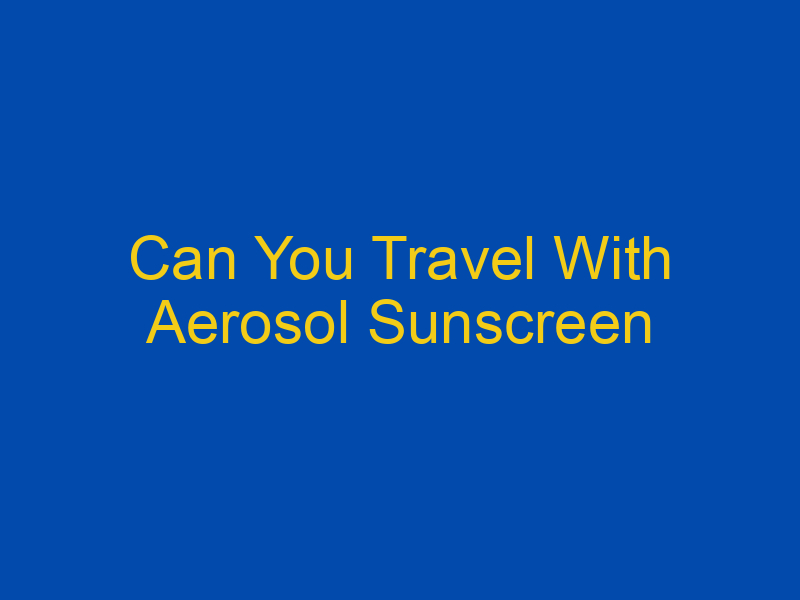As someone who loves to travel, I always make sure to pack all the essentials for my trips. One item that is a must-have in my suitcase is sunscreen – especially when traveling to sunny destinations. However, it wasn’t until recently that I realized there may be restrictions on traveling with aerosol sunscreen.
After doing some research and speaking with TSA officials, I discovered that there are guidelines for bringing aerosol sunscreen on flights. While it may seem like a simple item to pack, there are potential dangers associated with carrying aerosol cans on planes.
In this article, I will discuss the regulations surrounding traveling with aerosol sunscreen and offer alternatives for those who prefer not to use them.
Understanding TSA Regulations for Aerosol Sunscreen
It’s important to understand the TSA regulations for aerosol sunscreen before packing it in your luggage. While aerosol sunscreens are allowed on planes, they must comply with certain restrictions and packaging requirements.
According to TSA guidelines, aerosol sunscreen containers should not exceed 3.4 ounces (100 milliliters) and must be placed in a clear plastic bag with other liquids or gels. Additionally, all aerosols must have a cap or locking mechanism to prevent accidental discharge during transport.
It’s also worth noting that some airlines may have their own specific rules regarding aerosol sunscreen, so it’s best to double-check with your airline before packing. By understanding these TSA regulations and following them properly, you can ensure that your spray sunscreen will safely make it through airport security without any issues.
When traveling with aerosol sunscreen, it’s important to keep in mind potential dangers associated with its use. The particles from spray sunscreens can be harmful if inhaled, especially for children or those with respiratory issues such as asthma. Additionally, many popular brands of aerosol sunscreen contain flammable ingredients which can pose a risk if exposed to heat or flames during transport.
Understanding these potential dangers will help you make an informed decision about whether or not to pack aerosol sunscreen for your travels.
Potential Dangers of Aerosol Sunscreen
Using spray sunscreen can pose risks, such as inhaling the particles or accidentally spraying it into your eyes.
In addition to these potential health effects, aerosol sunscreen also has a negative environmental impact. The propellants used in these products contribute to air pollution and can harm marine life if they end up in bodies of water.
As someone who cares about my health and the environment, I’ve started exploring alternatives to using aerosol sunscreen. While it may take a bit more effort to apply, using mineral-based sunscreens or lotions can still provide effective protection from the sun’s harmful rays without posing the same risks or harming the environment.
Alternatives to Aerosol Sunscreen
As someone who values both personal well-being and environmental sustainability, I’ve begun exploring alternative options for protecting my skin from harmful UV rays.
One of the best alternatives to aerosol sunscreen is using products with natural ingredients. These types of sunscreens typically use zinc oxide or titanium dioxide as active ingredients, which are minerals that physically block out UVA and UVB rays without being absorbed into the skin. Not only are these ingredients safer for our bodies, they’re also better for the environment since they don’t contain harmful chemicals that can harm marine life and ecosystems.
Another eco-friendly option is using re-usable fabric shields like UPF-rated clothing or hats to block out the sun’s harmful rays. This way, you won’t have to apply any product at all while still staying protected from sun damage.
Ultimately, finding an alternative to aerosol sunscreen comes down to personal preference and lifestyle needs. However, by prioritizing natural ingredients and eco-friendly options, we can protect ourselves while also minimizing our impact on the environment.
Choosing the Right Sunscreen for Your Needs
Don’t risk damaging your skin and the environment, make sure to choose the perfect sunscreen that suits your needs and goals. When it comes to selecting a sunscreen, it’s important to consider factors such as your skin type, activity level, and the amount of sun exposure you’ll be getting.
Here are some tips for choosing the right sunscreen:
- Check the ingredients: Look for sunscreens that contain zinc oxide or titanium dioxide as they provide broad-spectrum protection against UVA and UVB rays without causing irritation.
- Consider SPF levels: A higher SPF doesn’t necessarily mean better protection. Stick to an SPF of 30 or higher as it provides adequate protection while also allowing vitamin D synthesis.
- Choose a water-resistant formula: If you plan on doing any water activities or sweating, opt for a water-resistant sunscreen.
- Avoid fragrances: Fragrances can cause skin irritation and allergic reactions, so choose fragrance-free options.
- Opt for eco-friendly options: Look for sunscreens that are reef-safe, biodegradable, vegan, cruelty-free.
Choosing the right sunscreen is crucial in protecting our skin from harmful UV rays. Now that we know what to look for in a sunscreen, let’s move on to how we can apply it correctly without missing any spots.
Applying Sunscreen Correctly
I want to talk about how to apply sunscreen correctly because it’s important for protecting your skin.
Firstly, it’s crucial to know how much sunscreen you should be applying – the general rule is a shot glass worth for your whole body.
Additionally, reapplication is key and should happen every two hours or after swimming or sweating heavily.
How Much to Apply
Make sure to apply enough of the product according to the instructions on the label, as using too little may not provide adequate protection from harmful UV rays. Proper application is key when it comes to sunscreen, and it’s important to avoid common mistakes like rubbing the product in too quickly or missing certain areas of your skin.
A good rule of thumb is to use about one ounce (or a shot glass full) of sunscreen for your entire body, and make sure to reapply every two hours or immediately after swimming or sweating.
When it comes to protecting yourself from the sun, applying sunscreen correctly is only half the battle. Reapplication guidelines are just as important as initial application guidelines, so be sure to keep these in mind when planning your day outdoors.
Reapplication Guidelines
If you want to avoid turning into a lobster, slather on more sunscreen every two hours or risk feeling the burn. Reapplying sunscreen is vital to keep your skin protected from harmful UV rays.
Here are some benefits of reapplying and the importance of choosing the right SPF:
- Benefits of reapplying:
- Ensures continuous protection throughout the day
- Helps maintain the effectiveness of sunscreen
- Reduces the risk of sunburn and skin damage
- Can prevent premature aging caused by sun exposure
It’s also crucial to choose the right SPF for your skin type and activity level. The American Academy of Dermatology recommends using at least SPF 30 for daily use and higher if you plan to be outside for an extended period.
Remember that no matter what SPF you use, it needs to be reapplied every two hours.
Now that we know why reapplication is necessary, let’s discuss timing and frequency without repeating ourselves.
Timing and Frequency
Don’t forget to keep track of time and remember to reapply your SPF every two hours to ensure maximum protection against harmful UV rays.
Sunscreen effectiveness also depends on the appropriate SPF level you choose for your skin type and activity level. The higher the SPF, the more protection you’ll get from the sun, but it doesn’t mean you can stay in the sun longer. It’s important to pick an SPF that matches your needs and lifestyle.
Additionally, other sun protection measures such as wearing protective clothing, a wide-brimmed hat, and seeking shade during peak hours (10 am – 4 pm) can further reduce your risk of sunburn and skin damage.
Remember that sunscreen is just one part of a comprehensive sun safety routine.
Other Sun Protection Measures
For added protection against harmful UV rays, it’s worth exploring alternative methods of shielding your skin from the sun. One option is to wear clothing that provides UV protection, such as long-sleeved shirts or pants made of lightweight and breathable materials. This can be particularly useful if you plan on spending extended periods outdoors during peak sunlight hours.
Another option is to seek shade whenever possible, whether it’s under a tree or an umbrella. In addition to these measures, don’t forget the importance of wearing sunglasses to protect your eyes and using a broad-spectrum sunscreen with at least SPF 30.
Remember that sunscreen should never be your only line of defense against the sun’s harmful rays, but rather one part of a comprehensive approach to sun protection. With these steps in mind, you can enjoy time outside while minimizing your risk of developing skin damage or cancer.
Conclusion and Final Thoughts
To fully protect myself from harmful UV rays, I always make sure to use a combination of sun protection measures. While sunscreen is an important part of my routine, I also seek shade when possible and wear protective clothing such as hats and long-sleeved shirts. Additionally, I always bring sunglasses to shield my eyes from the bright sun.
However, there are both pros and cons to using aerosol sunscreen specifically. On one hand, it can be convenient for reapplying on-the-go and easily covering hard-to-reach areas such as the back. On the other hand, it may not provide as thorough coverage as traditional lotion sunscreen and can potentially harm the environment if not disposed of properly.
Ultimately, personal experience and preference play a role in deciding whether or not to travel with aerosol sunscreen.
Frequently Asked Questions
Can I bring aerosol sunscreen in my checked luggage instead of my carry-on?
When it comes to packing for a trip, one of the most important things to consider is checked luggage safety and airline regulations. It’s crucial to know what you can and cannot bring on your flight, especially if you’re checking in your bags instead of carrying them on board.
In regards to sunscreen, many people wonder if they can bring aerosol sunscreen in their checked luggage instead of their carry-on. The answer is yes, but you should still be cautious and follow proper guidelines. Make sure that the aerosol sunscreen is not expired or damaged, as this could cause potential harm during transportation.
Additionally, double-check with your airline’s regulations regarding aerosol cans before packing them in your checked bag. By taking these precautions, you can ensure a safe and stress-free travel experience.
Are there any specific brands or types of aerosol sunscreen that are not allowed on airplanes?
When it comes to aerosol sunscreen, there are some potential risks to be aware of. Some people may find that the mist doesn’t cover evenly, which can leave unprotected areas and lead to sunburns. Additionally, there are concerns about inhaling the spray, which can be harmful to your lungs over time.
As for specific brands or types that aren’t allowed on airplanes, I’m not aware of any restrictions beyond the usual TSA guidelines for liquids in carry-on bags. However, if you’re concerned about traveling with aerosol sunscreen or just want an alternative option, there are plenty of other types of sunscreen available such as lotions or sticks that may work better for you.
How often should I reapply aerosol sunscreen during a flight?
I always make sure to pack my aerosol sunscreen whenever I travel, but one concern that often comes up is how often to reapply during a flight.
While it may seem like you’re not getting much sun exposure while on a plane, the truth is that UV rays can still penetrate through windows and cause damage to your skin. That’s why it’s important to continue applying sunscreen every two hours, even if you’re just sitting in your seat.
Keep in mind that the effectiveness of sunscreen can also be affected by factors such as sweating or rubbing against clothing or furniture. By being diligent about reapplying frequency, you’ll be able to ensure maximum protection for your skin while traveling.
Is it safe to use aerosol sunscreen on children or infants?
When it comes to infant safety, using aerosol sunscreen can be a bit concerning. The particles in the spray can be inhaled, causing potential harm to their delicate respiratory systems.
As a parent, I know how important it is to protect my child’s skin from harmful UV rays, but I also want to make sure that any product I use is safe for them. Thankfully, there are alternative options available such as mineral-based sunscreens or lotions that can provide the same level of protection without the risk of inhalation.
It’s always best to consult with your pediatrician before applying any new products on your baby’s sensitive skin to ensure their safety and well-being.
What should I do if my aerosol sunscreen accidentally sprays onto someone else during a flight?
As I was on a flight, I accidentally sprayed my aerosol sunscreen onto the passenger next to me. It was like a mini hailstorm of sunscreen particles scattered all over their clothes and face.
In that moment, I felt mortified and helpless. However, there are decontamination procedures that can be followed to prevent any harm caused by the accidental exposure.
It is important to immediately inform the flight attendants and ask for their assistance in providing first aid measures. Moreover, liability issues may arise if the person exposed suffers from any allergic reactions or injuries due to negligence or mishandling of the situation.
So, it’s always better to take precautions and avoid such accidents while travelling with aerosol sunscreen.
Conclusion
Well, that’s a lot of information to digest! It’s clear that traveling with aerosol sunscreen can be tricky due to TSA regulations and potential dangers. However, there are alternatives, such as lotion or stick sunscreen, that can still provide the same level of protection without the risk.
One interesting statistic to note is that, according to the American Academy of Dermatology, only about 30% of Americans regularly wear sunscreen, despite skin cancer being the most common type of cancer in the United States. This serves as a reminder to prioritize sun protection not just while traveling, but in our everyday lives as well.
It’s important to choose the right sunscreen for our individual needs and apply it correctly, while also taking additional measures, such as seeking shade and wearing protective clothing. With these precautions in mind, we can enjoy our travels without compromising on sun safety.

Meet Michael Graham, the main author of SeekTraveler.com. With a wanderlust that knows no bounds, Michael has traversed more than 30 countries across the globe. From sun-soaked Caribbean islands to the ancient marvels of Europe and the captivating charm of Japan, he has witnessed the wonders of diverse cultures firsthand. Michael’s in-depth knowledge and contagious enthusiasm for travel will inspire you to pack your bags and embark on your own extraordinary journey.



